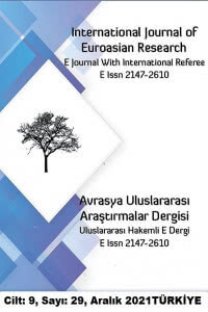İSMET İNÖNÜ-2 BULVARI’NDAKI KAMUSAL VE ÖZEL ALANLARIN DÖNÜŞÜMÜ
THE TRANSFORMATION OF PUBLIC AND PRIVATE SPACES ALONG ISMET INONU-2 BOULEVARD
___
- AKSOYLU, Sevin, (2012), “Cumhuriyet Dönemi’nde Sanayi Tesislerinin Eskişehir’in Mekansal Gelişimine Etkileri”, Eskişehir Valiliği, Eskiyeni Dergisi, Year:4, p. 48-56
- BANERJEE, Tridib, (2001), The Future of Public Space: Beyond Invented Streets and Reinvented Places, Journal of the American Planning Association, Winter 2001, Vol:67, No:1, Routledge
- BENJAMİN, Walter, (1995), Pasajlar, İstanbul: Yapı Kredi
- BENLİAY, A., SOYDAN, O., KARTAL, S., (2015), “Atatürk Caddesi Kent İmajı Öğelerinin Zamansal Değişimi”, Uluslararası Hakemli Mimarlık ve Tasarım Dergisi (MTD), Sayı: 05 İlkbahar Yaz, S:39-58, Doi: 10.17365 / TMD.2015511327
- BOZDOĞAN, Sibel, (2008), Art and Architecture in Modern Turkey: The Republican Period, Kasaba, R. (Ed.). London: Cambridge University, p.419-471
- CARMONA, Matthew, (2010), Contemporary public space, part two: classification. Journal of urban design, 15(2), 157-173.
- ERTİN, Gaye, (1994), Eskişehir Kentinde Yerleşmenin Evrimi, Eskişehir: Anadolu Üniversitesi
- GOLDBERGER, Paul, (1996), The Rise of the Private City, Carmona, M., Tiesdell, S. (Ed.). Oxford: Elsevier. p.170-176
- HARVEY, David, (2006), The political economy of public space, The politics of public space, p.17-34.
- KOSTOF, Spiro, (1985), The Study of What We Built in A History of Architecture: Settings and Rituals, New York: Oxford
- LEFEBVRE, Henry, (1973), The Production of Space, Leach, N. (Ed.). London and New York: Routledge. p. 139-148
- LYNCH, Kevin, (1990), “The Openness of the Open Space (1965)”, in City Sence and City Design, Cambridge, Massachusetts, London, England: MIT
- OLDENBURG, Ray, (2007), The Character of Third Places, Carmona, M., Tiesdell, S. (Ed.). Oxford: Elsevier. pp.170-176
- ÖZDEMİR, E. ve CENGİZOĞLU, P. (2016), “Çağdaş Alışveriş Merkezlerinde Kamusal Mekân Nitelikleri Ve Mersin Forum Avm Örneği” Uluslararası Hakemli Mimarlık ve Tasarım Dergisi (MTD), Sayı: 07 Kış İlkbahar, S:55-72, Doi: 10.17365 / TMD.2016716507
- SENNETT, Richard, (1999), Gözün Vicdanı: Kentin Tasarımı ve Toplumsal Yaşam, İstanbul: Ayrıntı
- ÜSTÜN, B. ve TUTAL, O. (2008), “Tüketim Alışkanlıklarındaki Değişimler ve Bu Değişimlerin Alışveriş Mekânlarına Etkisinin Eskişehir Örneğinde İrdelenmesi”, Anadolu Üniversitesi Sosyal Bilimler Dergisi, Cilt:08, Sayı:2
- www.eskisehir.net (last visited on 30th December 2015)
- www.googleearth.com (last visited on 30th December 2015)
- www.googleearth.com (last visited on 21st October 2020)
- ISSN: 2147-2610
- Yayın Aralığı: 4
- Başlangıç: 2012
- Yayıncı: Kürşat Öncül
RUS GÖÇMEN EDEBİYATININ UZAK DOĞU’DAKİ SESİ: ÇURAYEVKA EDEBİYAT TOPLULUĞU VE RUBEJ DERGİSİ
AŞIRI EBEVEYNLİK, ENÇOKLAMACI KARAR VERME EĞİLİMLERİ VE KARİYER KARARSIZLIĞI İLİŞKİSİ: SİNOP ÖRNEĞİ
RUS VE TÜRK DİL DÜNYA GÖRÜŞLERİNDE AİLE KONSEPTİ
ÖĞRENCİLERİN PROGRAM TERCİHLERİ ÜZERİNE ANALİTİK BİR DEĞERLENDİRME: MODA TASARIMI PROGRAMI ÖRNEĞİ
DEDE KORKUT HİKÂYELERİNİ FEMİNİST KURAM BAĞLAMINDA OKUMA
TÜRK MODERNLEŞME SÜRECİNDE KADINLARIN EĞİTİM HAKLARI ÜZERİNE DÜZENLEMELER
MİLLİ MÜCADELE DÖNEMİNDE EMİRDAĞ
REFİK HALİD KARAY’IN “MEMLEKET YAZILARI”NDA HALK BİLİMİ VE MESLEK FOLKLORU
